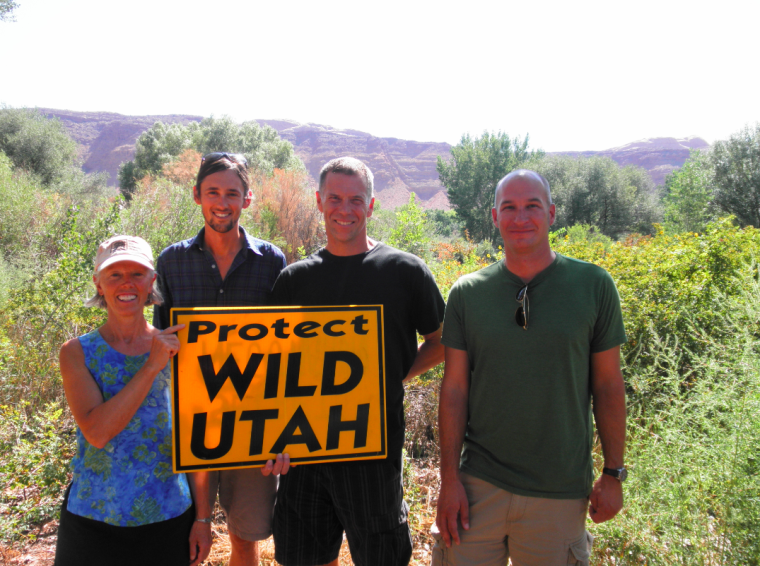Some information may be outdated.
This year the Southern Utah Wilderness Alliance (SUWA) celebrates its 30th anniversary. For Scott Groene, SUWA’s executive director, the progress that the organization has made in the last three decades pursuing its mission of protecting wilderness areas on the Colorado Plateau has been substantial.
“The initiatives taking place for southeast Utah right now are the result of 30 years of work,” he said of SUWA’s current campaigns, which include the push to create Greater Canyonlands National Monument.
“In a period of probably 50 years (before SUWA was founded) half of the BLM (Bureau of Land Management) wilderness disappeared. About 13 million acres destroyed. In the 30 years since then, less than 1-percent has been lost and that is because of the citizens’ movement to protect these lands.”
And Groene believes that SUWA has been one of the principal forces behind that movement.
SUWA was first created in 1983 “by a bunch of guys in Boulder, Utah” in response to what they saw as terrible management of BLM land, Groene said.
The group, headed by Clive Kincaid, felt that huge sections of the wilderness that the BLM was supposed to protect, were being excluded from the agency’s surveys. So they organized to defend those areas.
When Groene joined SUWA in 1987 it was still a small organization, run on a shoestring budget.
Before Groene worked for SUWA, he was working as a lawyer in Mexican Hat defending people under the poverty line. Many of the people he defended were part of the Navajo Nation.
“That I did work in Mexican Hat and was still willing to go there was the qualification that got me hired,” he laughed.
Then in the mid-‘90s SUWA began to grow in numbers and influence. The catalyst for that growth was the organization’s successful opposition to the 1995 Utah Public Lands Development Act, a bill that would have opened up large areas of the state’s wilderness to development.
“At that time there had never been a bill pushed by a united delegation that had been stopped in the nation’s history,” Groene said. “Once people learned that they could do things that a bunch of people had thought were impossible it really changed their perspective. Since then we have killed probably a dozen bills.”
That success led to a huge growth in support and funding that has allowed SUWA to now have offices in Salt Lake City, Moab, and Washington D.C. They now employ 20 people, have 13,000 paying member/activists, and an operating budget of around $2 million.
“SUWA has gained a great deal of respect over the years. A lot of our opponents in the first decade or two thought we would just go away,” said Matt Gross, the media director at SUWA. “I think now people realize we are not going away.”
Their success has only strengthened their resolve to defend wilderness areas in Utah.
“The SUWA staff is extremely committed to protecting the remaining wild lands in Utah,” said Neal Clark, a field attorney at SUWA’s Moab office. “One of the things about working at SUWA is that the areas that we work to protect really do speak for themselves. It is one of the most beautiful and awe-inspiring landscapes in the world.”
Having a limited and narrow focus is what Groene, Gross, Clark and Liz Thomas all believe has allowed SUWA to be so successful; by focusing on federal lands in southern Utah, SUWA doesn’t have to worry about competing priorities in the way that organization’s with broader missions do.
During his career with SUWA Groene has also seen big changes in Moab.
“Moab has changed dramatically from when I was the only full-time activist on environmental issues,” he said. “We don’t get death threats anymore.”
Though SUWA has made impressive strides towards their goal, they believe that there is still much work to be done before Utah’s wilderness is adequately protected. Two of the major issues the group is now focusing on are the proposed Greater Canyonlands National Monument and stopping what they see as Utah Gov. Herbert’s federal land grab.
“The opposition (to wilderness conservation) is pretty deep seated and will last for a long time. It’s gone on for decades. It’s not going to end any time soon,” Groene said.
“Every time there has been a dramatic conservation gain, whether the first protection of Arches (National Park), Canyonlands (National Park), or Grand Staircase (-Escalante National Monument), its incredibly controversial and then 20 years down the road everyone agrees that it was a good idea,” he continued. “It’s inevitable that large amounts of Utah’s wilderness will be protected, whereas that wasn’t true 25 years ago.”
Appreciate the coverage? Help keep local news alive.
Chip in to support the Moab Sun News.





